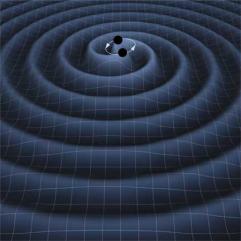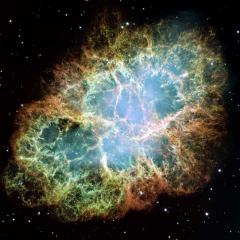Colloquium
Coalescence of intermediate-mass black holes: Implications for GW Astronomy

- An artist's representation of the burst of gravitational waves resulting from the collision of a colliding pair of black holes.

- © LIGO Scientific Collaboration (LSC) / NASA
Dr. Pau Amaro-Seoane
(AEI Potsdam-Golm)
Freitag/Friday, 2014-12-05, 14:00 c.t., EW 561
Eugene-Paul-Wigner Gebäude, Hardenbergstr. 36, 10623 Berlin
Zusammenfassung/Abstract:
Observations suggest that star clusters often form in binaries or larger bound groups. Therefore, mergers between two clusters are likely to occur. If these clusters both harbour an intermediate-mass black hole (IMBH; ~100-10,000 M$_\odot$) in their center, they can become a strong source of gravitational waves when the black holes merge with each other.
Pulsare. Physik extrem.
Prof. Jocelyn Bell Burnell - die Frau, die den ersten Pulsar entdeckte.
(University of Oxford)
Mittwoch/Wednesday, 2014-11-19 16:00 s.t., EW 201 (Achtung: Raumänderung!)
Eugene-Paul-Wigner Gebäude, Hardenbergstr. 36, 10623 Berlin
(Vortrag in Englisch)
Zusammenfassung/Abstract:
Pulsare sind pulsierende Sterne, in denen physikalische Prozesse unter extremen Bedingungen ablaufen: Magnetfelder, die Billiardenfach größer sind als das Erdmagnetfeld, extrem hohe Dichten und Geschwindigkeiten. Diese Objekte drehen sich wie gigantische Leuchttürme und bei einigen dauert eine Umdrehung nur eine Tausendstelsekunde.
In diesem Vortrag wird Jocelyn Bell Burnell, die 1967 den ersten Pulsar entdeckte, die physikalischen Eigenschaften der Pulsare erklären und die Fortschritte auf dem Gebiet der Extremphysik erläutern.
The Structure of the Outer Heliosphere and the Local Interstellar Medium: Implications from the Voyager and IBEX Missions
PD Dr. Horst Fichtner
(Ruhr-Universität Bochum)
Donnerstag/Thursday, 2014-10-23 17:00 c.t., EW 202
Eugene-Paul-Wigner Gebäude, Hardenbergstr. 36, 10623 Berlin
Im Rahmen des Physikalischen Kolloquiums
Zusammenfassung/Abstract:
In recent years, the Voyager and IBEX spacecraft have tremendously increased our knowledge about the structure of the outer heliosphere, i.e. the circumsolar space occupied by the solar wind plasma, and the interstellar medium beyond. Their complementary in situ and remote measurements have led to a critical revision of long-standing paradigms and have triggered a new understanding of the outer boundary region of the heliosphere. A corresponding overview will be given along with a discussion of the propagation physics of energetic particles in this heliospheric regime and its significance for our understanding of heliospheric and local interstellar structure as well as of fundamental transport processes.
Molecular Hydrogen and the latest Bounds on the Variation of the Proton-to-Electron Mass Ratio
Dr. Martin Wendt
(Institut für Physik und Astronomie, Universität Potsdam)
Freitag/Friday, 2014-01-24, 15:00 c.t., EW 226
Eugene-Paul-Wigner Gebäude, Hardenbergstr. 36, 10623 Berlin
Zusammenfassung/Abstract:
Molecular hydrogen is the most abundant molecule in the universe and plays a fundamental role in many astrophysical contexts. It is found in all regions where the shielding of the ultraviolet photons, responsible for the photo-dissociation of H2, is sufficiently large.
Autonomous Robotic Exploration for Extreme Space Environments
Dr. Wolfgang Fink
(University of Arizona, Tucson, USA)
Freitag/Friday, 2013-12-20, 14:00 s.t., EW 015
Eugene-Paul-Wigner Gebäude, Hardenbergstr. 36, 10623 Berlin
Zusammenfassung/Abstract:
Robotic exploration is called for in extreme space environments, including planetary atmospheres, surfaces, and subsurfaces, as well as in potentially hazardous or inaccessible operational areas on Earth. Such future missions will require increasing degrees of operational autonomy, especially when following up on transient events.
Probing dark matter and the expansion history of the Universe with Lyman-alpha absorption in the spectra of distant quasars
Prof. Martin Haehnelt
(Institute of Astronomy und Kavli Institute for Cosmology der University of Cambridge)
Donnerstag/Thursday, 2013-05-30 17:00 c.t., EW 202
Eugene-Paul-Wigner Gebäude, Hardenbergstr. 36, 10623 Berlin
Sonderkolloquium im Physikalischen Kolloquium
Zusammenfassung/Abstract:
The Lyman-alpha forest in the spectra of distant quasars is a sensitive probe of the overall matter distribution in the Universe as well as the physical state of the Intergalactic Medium. I will present constraints on the mass of (warm) dark matter particles and discuss the ionization state of the Intergalactic Medium. I will further discuss prospects of measuring the redshift drift due to the expansion of the Universe and improving constraints on the variability of fundamental constants with the ultra-stable high-resolution spectrograph proposed for the next generation 40m diameter optical telescope of the European Southern Observatory.
Supernovae and Gamma Ray bursts: the concept of Induced Gravitational collapse
Prof. Remo J. Ruffini
(University „La Sapienza”, Rome, Italy)
Donnerstag/Thursday, 2013-01-17 16:00 s.t., EW 203
Eugene-Paul-Wigner Gebäude, Hardenbergstr. 36, 10623 Berlin
Cosmic Wave-Particle Interaction: Astrophysical Magnetic Turbulence and High-Energetic Particles
Dr. Robert Tautz
Vorstellungsvortrag zur Habilitation
Freitag/Friday, 2012-11-16 13 Uhr, EW 015
Eugene-Paul-Wigner Gebäude, Hardenbergstr. 36, 10623 Berlin
Hot intergalactic gas in clusters of galaxies, cosmic microwave background radiation, and cosmology
Prof. Dr. Rashid Sunyaev
(Max-Planck-Institut für Astrophysik,Garching; Space Research Institute, Moscow, Russia; Institute for Advanced Study, Princeton, USA)
Donnerstag, den 17. Januar 2013, um 18.30 Uhr im Magnus-Haus
Am Kupfergraben 7, 10117 Berlin
Vortrag im Rahmen des Berliner Physikalische Kolloquium (BPK) im Magnus-Haus.
Zusammenfassung/Abstract:
Clusters of galaxies are the most massive objects in our universe. Each of them contains dark matter, thousands of galaxies, and is filled with hot intergalactic gas radiating x-rays. An unusual method to detect clusters of galaxies is possible due to the presence of extremely isotropic Cosmic Microwave Background (CMB) radiation filling our universe. The interaction of hot electrons with CMB photons changes the CMB spectrum in the directions toward clusters of galaxies. As a result, clusters become “negative sources” of radiation in the cm and mm spectral bands. The brightness and spectrum of these sources does not depend on the distance or redshift. This opens the way to detect all clusters of galaxies (more than 100,000) in the observable universe.
Planetary Exploration of Habitable Planets and Moons
Prof. Dr. Dirk Schulze–Makuch
(Washington State University - School of Earth & Environmental Sciences)
Freitag/Friday, 2012-7-20 14:00, EW 114
Eugene-Paul-Wigner Gebäude, Hardenbergstr. 36, 10623 Berlin
Abstract
One major motivation for the exploration of our vicinity of the galaxy is the search for habitable planets, where life can be found or where we can establish future colonies (e.g., through NASAs 100–year Starship Project). This talk will focus on what habitability means in a planetary context and discuss the concept in detail for examples within and outside of our Solar System. Emphasis will be placed on Titan for the likely assembly of organic molecules and possibly even macromolecules in an unusual planetary setting and Gliese 581d, a Super-Earth in a Mars-type orbit around an M-star.


